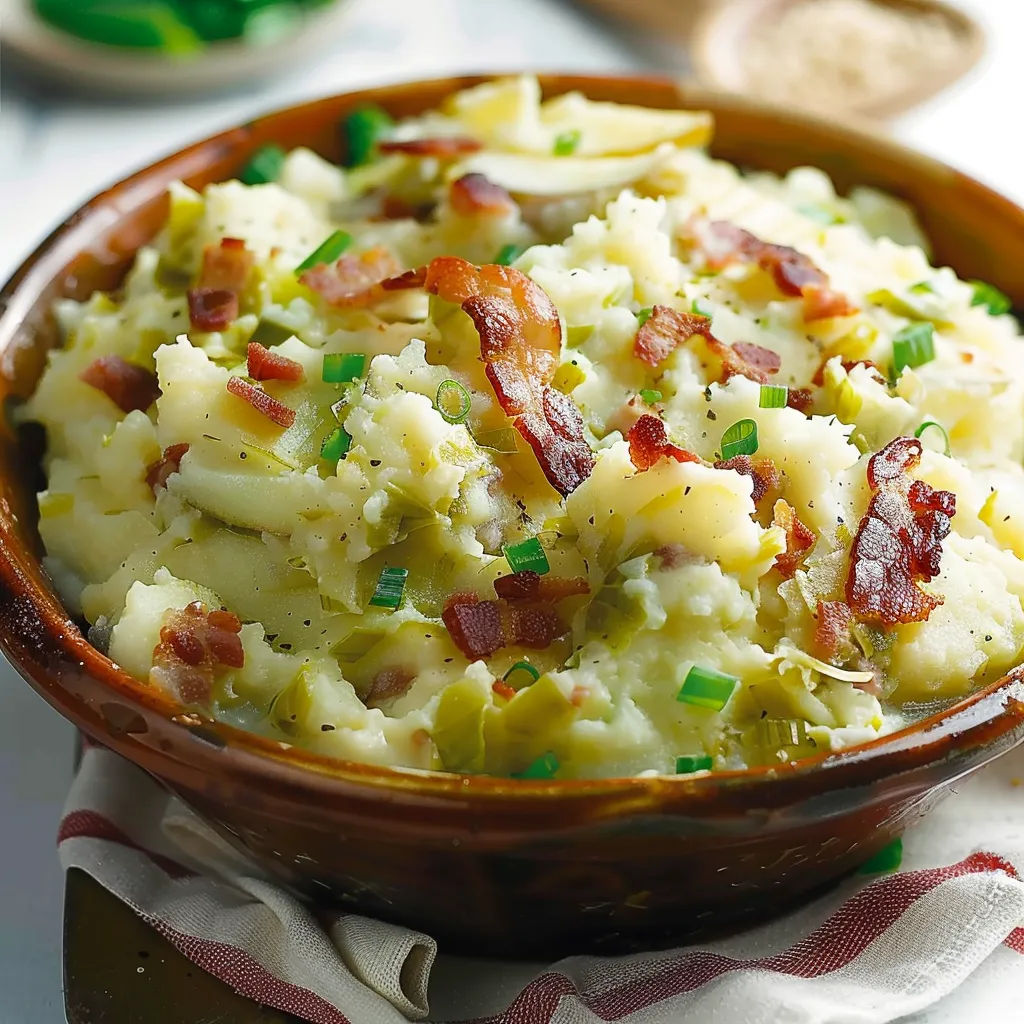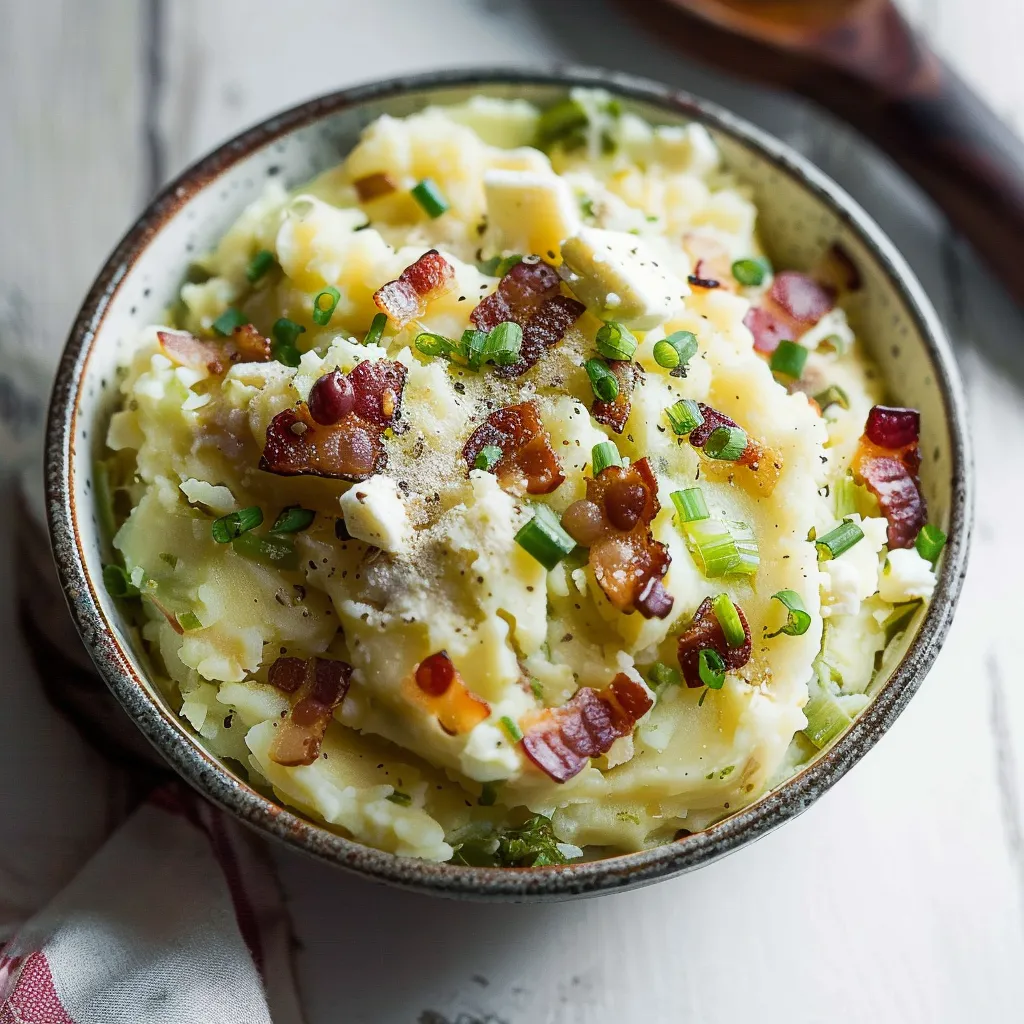 Pin to Favorites
Pin to Favorites
This traditional Irish Colcannon transforms humble ingredients into something truly magical—creamy mashed potatoes enriched with butter and cream, gently folded with tender braised cabbage and leeks, then studded with crispy bacon for a perfect textural contrast. Each forkful delivers a harmonious blend of comfort and flavor, with the earthiness of potatoes balanced by the slight sweetness of properly cooked cabbage and the savory punch of bacon. More than just a side dish, this beloved Irish classic represents generations of home cooking, creating a connection to Ireland's culinary heritage in one satisfying, cozy bowlful.
Last winter, I served this alongside a simple roast chicken, and my normally potato-indifferent friend asked for seconds, then the recipe. The secret lies in proper potato selection and the gentle cooking of the cabbage, which prevents any sulfurous flavors from developing.
Essential Ingredients and Selection Tips
- Potatoes: Choose a variety with medium starch content like Yukon Gold or Red Rooster for the ideal balance of creaminess and structure. Russets work well for a fluffier result.
- Savoy Cabbage: Offers the best texture and mild flavor. Regular green cabbage works but needs longer cooking.
- Leeks: Provide a delicate onion flavor. Wash thoroughly to remove any grit.
- Butter: High-quality unsalted butter like Kerrygold adds richness.
- Milk and Cream: Whole milk and heavy cream create the perfect richness.
- Bacon: Irish back bacon is traditional, but thick-cut American bacon works well too.
 Pin to Favorites
Pin to Favorites
Detailed Cooking Instructions
- Begin with the Cream Mixture:
- In a saucepan, melt ½ cup butter with 1 cup whole milk and ¼ cup heavy cream over low heat. Keep warm.
- Prepare the Vegetables:
- Peel and chop 3 pounds of potatoes into 1½-inch chunks. Submerge in cold water. Shred ½ a medium Savoy cabbage and slice 2 medium leeks into thin half-moons.
- Cook the Bacon:
- Cook 6 slices of thick-cut bacon until crispy, about 8-10 minutes. Remove and set aside, reserving the rendered fat.
- Sweat the Leeks:
- In the bacon fat (or 2 tbsp butter), cook leeks with a pinch of salt over medium-low heat until softened.
- Braise the Cabbage:
- Add shredded cabbage to the pan with another pinch of salt. Cover and cook for 6-7 minutes, stirring occasionally.
- Boil the Potatoes:
- Boil potatoes in salted water until tender, 15-20 minutes. Drain well and return to the hot pot.
- Infuse the Cream Mixture:
- Add the white portions of 4-5 sliced green onions to the warm cream mixture. Keep warm.
- Mash the Potatoes:
- Use a potato ricer or masher to achieve the desired consistency.
- Combine with Care:
- Gradually fold in the warm cream mixture, followed by the braised cabbage, leeks, and green onion tops.
- Final Touches:
- Fold in crumbled bacon, reserving some for garnish. Adjust seasoning and serve with a pat of butter in the center.
The Cultural Connection Story
My first encounter with authentic Colcannon came during a rainy March visit to County Cork, where I was invited to a family's home for Sunday dinner. The matriarch, Mrs. O'Sullivan, shared how Colcannon was once a year-round staple, not just a St. Patrick's Day dish. She recounted how small coins were once hidden in the Colcannon for children—a tradition mostly abandoned for safety reasons. That evening, as we ate together, I realized how food could tell a story of resilience, tradition, and familial warmth. Every time I make Colcannon, I remember that simple yet meaningful meal.
The Seasonal Variation Discovery
Colcannon adapts beautifully to the seasons. In spring, tender young cabbage and fresh leeks create a lighter version. In summer, new potatoes bring sweetness. Autumn calls for heartier kale, while winter versions incorporate parsnips or turnips. The most successful variation was an early fall batch with roasted garlic and garden-fresh herbs, proving that traditional dishes can evolve while honoring their roots.
The Family Meal Evolution
Originally a side dish, Colcannon became a complete one-pot meal in my household. Increasing the vegetables and adding more bacon (or even Irish sausage) makes it heartier. White beans or a poached egg on top transform it further. My young nephew, a picky eater, even declared it his favorite dinner—without realizing he was eating multiple vegetables. This evolution reflects how traditional dishes naturally adapt to meet family needs over time.
The Leftover Reimagination Journey
Leftover Colcannon is a treasure trove of possibilities. Pan-fried into crispy potato cakes, it makes a perfect breakfast. Rolled into croquettes and baked, it becomes a savory appetizer. My biggest surprise came when I used it as a filling for hand pies—enclosed in pastry and baked until golden. These transformations remind me that leftovers aren’t just repeats; they’re opportunities for creativity.
The Unexpected Health Adaptation
When a family member needed a lower-fat diet, I feared Colcannon might be off the menu. Replacing half the potatoes with steamed cauliflower, using chicken broth instead of cream, and swapping in olive oil for some butter created a lighter version that still captured the essence of the dish. Seeing their delighted reaction reinforced my belief that traditional recipes can adapt to modern health needs without losing their soul.
Chef’s Essential Tips
Creating a proper Irish Colcannon connects us to generations of home cooks who transformed simple ingredients into deeply satisfying food. Following time-honored techniques—gently cooking cabbage, mashing potatoes to the perfect consistency, and incorporating good butter and cream—ensures an unforgettable dish. The appreciative silence that follows the first bite tells me that some foods transcend their simplicity, offering both comfort and a link to the past.
 Pin to Favorites
Pin to Favorites
Frequently Asked Questions
- → What is the best type of cabbage to use for Colcannon?
- Savoy cabbage is ideal for Colcannon as specified in the recipe because its tender, crinkled leaves cook quickly and have a milder flavor. However, green cabbage or kale are traditional alternatives that work well too.
- → Can I make Colcannon without bacon for a vegetarian version?
- Yes, you can omit the bacon and sauté the leeks and cabbage in butter instead. To replace some of the smoky flavor, consider adding a teaspoon of smoked paprika or a few drops of liquid smoke to the vegetables while cooking.
- → What's the difference between Colcannon and Champ?
- Both are Irish potato dishes, but Colcannon contains cabbage or kale mixed with mashed potatoes, while Champ is mashed potatoes mixed with scallions (green onions). This recipe actually incorporates elements of both traditional dishes.
- → What's the best way to serve Colcannon?
- Traditionally, Colcannon is served with a well in the center filled with additional melted butter. It pairs perfectly with Irish sausages, boiled ham, or corned beef. It's also delicious on its own as a hearty vegetable-forward main dish.
- → Why does the recipe call for two types of potatoes?
- Using both russet and Yukon gold potatoes creates the perfect texture and flavor balance. Russets are starchy and fluffy, while Yukon golds are creamier with a buttery flavor. Together, they make an ideal mashed potato base for Colcannon.
